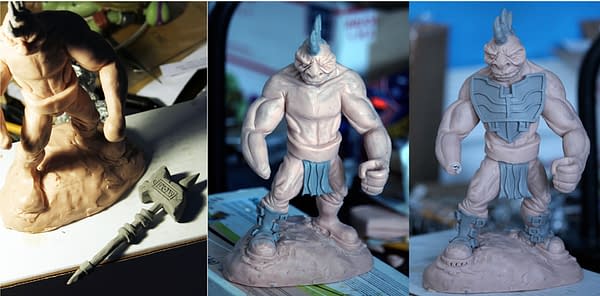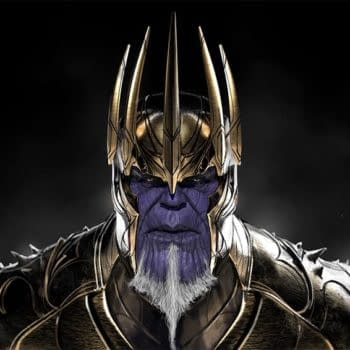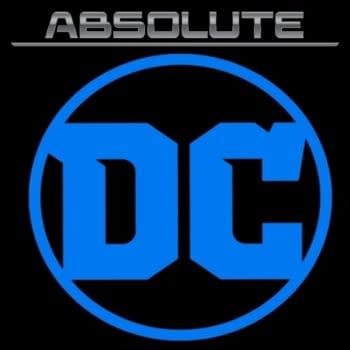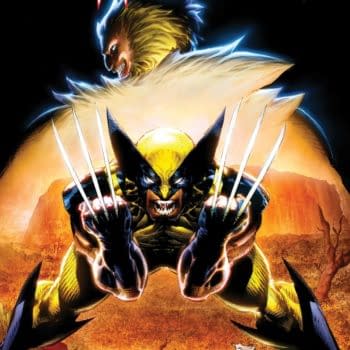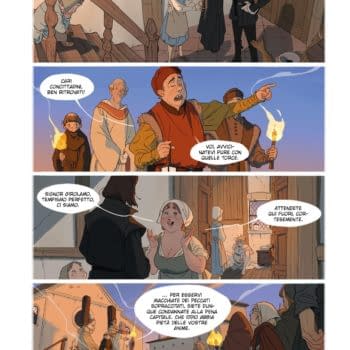Posted in: Comics | Tagged: bigfoot, Comics, entertainment, kickstarter
Bigfoot… And the Making of a Monster
Joshua Henaman writes,
What originally began as a two-part series detailing the journey of self-publishing my sword, sorcery and sasquatch epic, Bigfoot – Sword of the Earthman, has appropriately evolved into what I now consider, "The Further Adventures of…"
You can catch up on part one and part two here:
As an indie-creator heading into the summer months of his second official con season, I'm constantly on the hunt for ways to get people's attention. So far, I've done the giant banner with the book's name, several upright displays to showcase the varying color-schemes of the big guy's first five issues and I even have a life-size 7-ft tall Bigfoot standee, all in an attempt to cut through convention hall clutter of what can only be described as a living comic book.
With everybody around me going bigger, larger and more in your face, for a comic about Bigfoot, I decided to go the opposite.
I decided to go small.
More specifically, I decided to test the waters with figurines (Bigfoot Action Figures!) I figured that seeing a comic book along the aisles of artists' alley is one thing, but seeing a 3D representation of an appropriately badass character come to life? That's something else.
Luckily, while I was attending the Long Beach Comic Con in 2013, I happened to be stationed across the aisle from the awesome guys over at Penguins Vs. Possums. It was through them that I was introduced to the mega-talented artist Sarah Braly, who they had commissioned for a series of figurines based on their book. After a few brief emails back and forth with Sarah, we decided on an appropriate first figure to bring to Wondercon… main Bigfoot baddie, the visually striking red demon of the desert, Korovan Muspin.
And the response at Wondercon was phenomenal (so much so that I've now commissioned two more figurines to round out the trilogy of awesome!)
So I caught up with Sarah, who was also appearing at Wondercon, and we talked a little about her process.
JH: So basics first. What kind of formal training did you have (sculpting, drawing, painting, etc.?)
SB: I am trained in Industrial Design, with a fine arts foundation.
JH: At what point did you figure out you had an eye for sculpting? What drew you to it? Would you say there is a "style" to your work (do you gravitate towards any one genre (fantasy, the macabre, sci-fi, etc.?)
SB: I have always liked to make 3-D creations, and began sculpting in High School. I went through a phase of making entire sets with characters in them. However I moved away from that work in college, where I was building models for industrial products with foam ad foam core, and casting those creations in resins and the like. After college I worked making posters for small production companies in LA and then as a fashion designer in New York, and didn't get back to actual sculpting in any major way until this last year. And then it took over as my main focus, along with illustrating comics. In terms of style, I like to run the gambit from cutesy, such as the zombie cupcakes I make to compliment my comic book High Fructose Zombies, to more Sci-Fi / hardcore, such as the Korovan sculpt I did for Bigfoot. I find it more fun and engaging to move back and forth between genres, so you're always doing something new,
JH: When you first sit down to sculpt, is it easier to approach a commission as a job or is there a certain freedom in that creation process that you latch onto?
SB: When I first sit down to do a commission, I have several primary goals / foci. First is time. I need to design the piece to match the amount of time that I have, or can allot to the project based on the price of the commission. This is the part where I decide which details are crucial to making the piece awesome, and what details can be removed. Second, I always like to do one new thing for every sculpt, whether it be adding a new type of detail, i.e. veins, or trying out a new finishing technique. This allows me to advance my technique with every piece I make by continuing to challenge myself, and makes it more interesting and fun. Third, I look at every commission as a collaboration. I like to let the style of the source art inspire and influence me, bringing detail or style ideas that I might not have thought of independently. There is something really cool as an artist about getting to merge your ideas with that of another artist.
JH: What's your creative environment like at that moment? Brightly lit, music blaring or no music with more of a serene setting?
SB: As I live in New York city, my work area is inherently a part of a space that has another purpose. In my case, it is in the kitchen, which happens to be an odd and cavernous room, creating a large (for NYC) space for me to work in. I have a large, multipurpose table, surrounded by shelves filled with my sculpts, and a small (though growing) collection of action figures. During the day I work by natural light, and then have a smaller desk lamp that I move based on where I am working at night. I alternate between music, audiobooks, and old radio programs, such as X Minus One, Suspense, The Shadow, and others of those ilk. The most striking feature of my workspace is the large mural of a rubber duck in an elizabethan collar floating in a blue, cloud filled sky, staring down at me as I work. In fact the blue extends to all the kitchen walls, punctuated with fluffy white clouds around the entire room. Aside from space, the kitchen is also the ideal workspace, as I sculpt primarily in Super Sculpey, a plasticine based clay which you bake in the oven to harden.
JH: Walk us through the process a little.
SB: Almost every sculpt begins with armature wire, of varying thicknesses depending on the size of the figure. This creates the interior sculpture and dictates the proportions of the figure, so it's important to make sure the measurements are correct at this stage. Then I rough out the body / figure with tinfoil. This a) helps the figure cook more evenly when I put it in the oven, b) makes the figure lighter weight and c) means I don't waste sculpey. Next I begin to add the Super Sculpey. I add a thicker layer than needed, so that I can carve away to get muscle tone and other structural base details. I use a combination of clay and wax sculpting tools, along with an exacto knife. Once the main form has been shaped and refined to a moderate point, I begin adding other components, such as armor, belts, or sculpted clothing elements (I will get to non-sculpted clothing elements in a little). For inorganic objects (ie. armor), or elements that need a high level of detail (i.e. buckles) I use firm Super Sculpey, which gives harder, crisper edges. Now near completion I go back in and add detailing where needed and begin smoothing the sculpt, to get rid of finger prints and the like. Just as you use water to smooth regular clay, you use alcohol, such as vodka, for plasticine clay. Once the sculpt is complete, I pop it in the oven for the appropriate amount of time. Once cooled, I prime the sculpt with a spray on plastic primer, and paint it. If the figure needs non-sculpted clothing, this is where I add it. Examples include shaped capes that flow out behind the character, skirts, or weapons slings. In these cases I will create a wire frame if needed, as in the case of the flowing cape, and then shape leather, tacking it with glue to hold folds and wrinkles as needed. Once the leather is shaped, glued down, and painted in the correct color, I go over it with several layers of polyurethane, which makes it more rigid and capable of holding its shape. Once the piece is completed I finish it off with either a matte or glazed varnish, as needed.
JH: In the Korovan sculpt, what was the most challenging aspect?
SB: The Korovan sculpt is definitely one of my favorite sculpts to date. While elements like the scales were a challenge and took up a good amount of time, I would have to say that the face, as it often is, was the most challenging aspect. The face is where you have the least amount of visual wiggle room. It is the part where you either capture the character or you don't. I reworked the face several times, and moved the nose up and down until it finally felt right. Taking a 2D drawing and turning it into a 3D sculpt is very much like translating one language to another – often you aren't looking to be 100% literal, but instead you seek to capture the essence.
JH: What are you working on next? Is there a character out there (of your own creation or of another artist) that you're just dying to sculpt but haven't found the time yet?
SB: There is never enough time to sculpt everything that I would like to. Every time I play a new video game, or read a new comic I see characters that I would just love to make. At the present, my line-up is primarily commissions, though I need to make time to squeeze my own projects in there, as I will have a booth in the Cultyard at NYCC in October which will be focused on my sculpts, though the trade of my comic book High Fructose Zombies will also be available.
JH: Where can we find more of you work, how to contact you, etc.?
SB: The most updated location for my work is https://www.facebook.com/sarahbralyartist. Additionally you can check out my website sarahbraly.com, or visit http://spulunk.deviantart.com. If anyone has any questions, comments, or is interested in a commission they can either email me at spulunk@gmail.com or hit me up on twitter @zombieswtattoos.
—
And there you have it. An awesome sculpt with two more on the way (just in time for the Amazing Las Vegas Comic Con in June!) Thanks again for sticking around as I continue to drunkenly stagger through the world of self-publishing.
And as always, if you go to www.bigfootcomic.com and order the Bigfoot Bundle (issues 2 – 5,) just say "I saw you on Bleeding Cool!" and I'll throw in issue #1 for free!



